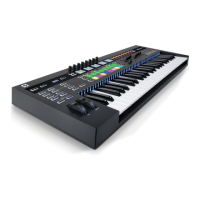26
SCALES
Enable/Disable Scales
Scales view provides an excellent entry point for beginners to start learning the fundamentals of chords and scales. It also
serves as an excellent refresher for intermediate players whose knowledge of harmony has become rusty.
Tempo INCONTROLGlobalShift
Zones
Sequencer
LatchArp
Scales
Sessions
Patterns
Steps
Save
Duplicate
Clear
Grid
Options
Pitch Modulation
Octave
Transpose
Track
_
+
Templates
Expand
To enable/disable Scales view hold Shift then press the
Scale button.
When Scales view is active notes will adhere to the scale
you select, whether playing the keys or using the Sequencer.
These scales range from traditional scales of Western music
(C Major, E Dorian etc.) to non-Western ones like Marva.
You can switch between scales in the Scale Settings (see
“Scale Settings” on page 26).
When Scale is enabled the LEDs above the keys have the
following behaviour:
• Root notes light brightly.
• Notes in the scale light dimly.
• Notes outside of the scale are off (unlit).
With Scales view on, playing keys (either dimly or brightly lit)
guarantees you are playing notes within your chosen scale.
Scale Settings
Pressing the ‘Scale’ button brings the Scale Settings onto
the screens.
Root Note
The left-most option labelled ‘Root’; lets you change the root
note of the scale. Turn the rotary knob above to set the root
of the scale from the following chromatic notes: C, C#, D, E,
Eb, F, F#, G, Ab, A, Bb, and B.
Scale Type
Turn the rotary knob above ‘Type’ to choose one of the
following scales:
• Natural Minor
• Major, Dorian
• Phrygian
• Mixolydian
• Melodic Minor
• Harmonic Minor
• Bebop Dorian
• Blues
• Minor Pentatonic
• Hungarian Minor
• Ukrainian Minor
• Marva
• Todi
• Whole Tone
• Chromatic.
Sequence Transpose
Turning the knob above ‘Sequence Transpose’ applies
a transpose value to the played notes coming from the
Sequencer. In other words, it shifts sequenced parts by a
set amount (e.g., five semitones).
It also functions independently of Root and Type, which
apply a scale to Sequencer parts without transposing notes.
You can transpose your Sequence up or down by 11
semitones (half-steps).

